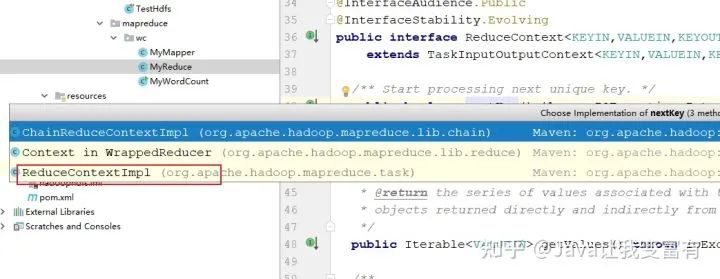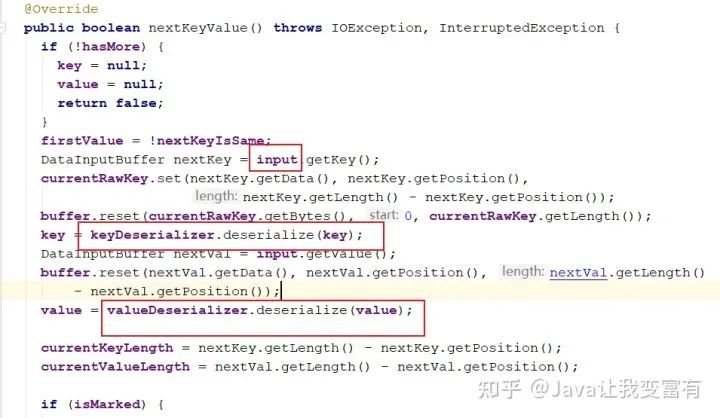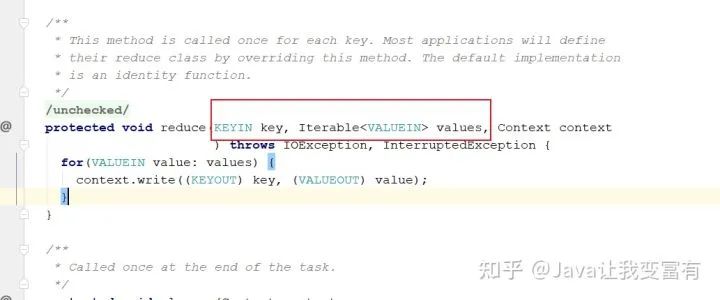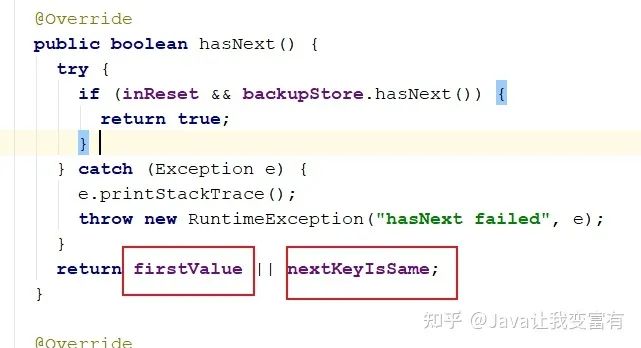MapReduce源码解析之ReduceTask
ReduceTask run
与MapTask中的写法呼应的比较多,因此看过MapTask之后,对ReduceTask理解可能会更加迅速。
public void run(JobConf job, final TaskUmbilicalProtocol umbilical)
throws IOException, InterruptedException, ClassNotFoundException {
job.setBoolean(JobContext.SKIP_RECORDS, isSkipping());
if (isMapOrReduce()) {
copyPhase = getProgress().addPhase("copy");
sortPhase = getProgress().addPhase("sort");
reducePhase = getProgress().addPhase("reduce");
}
// start thread that will handle communication with parent
TaskReporter reporter = startReporter(umbilical);
boolean useNewApi = job.getUseNewReducer();
initialize(job, getJobID(), reporter, useNewApi);
// check if it is a cleanupJobTask
if (jobCleanup) {
runJobCleanupTask(umbilical, reporter);
return;
}
if (jobSetup) {
runJobSetupTask(umbilical, reporter);
return;
}
if (taskCleanup) {
runTaskCleanupTask(umbilical, reporter);
return;
}
// Initialize the codec
codec = initCodec();
RawKeyValueIterator rIter = null;
ShuffleConsumerPlugin shuffleConsumerPlugin = null;
Class combinerClass = conf.getCombinerClass();
CombineOutputCollector combineCollector =
(null != combinerClass) ?
new CombineOutputCollector(reduceCombineOutputCounter, reporter, conf) : null;
Class extends ShuffleConsumerPlugin> clazz =
job.getClass(MRConfig.SHUFFLE_CONSUMER_PLUGIN, Shuffle.class, ShuffleConsumerPlugin.class);
shuffleConsumerPlugin = ReflectionUtils.newInstance(clazz, job);
LOG.info("Using ShuffleConsumerPlugin: " + shuffleConsumerPlugin);
ShuffleConsumerPlugin.Context shuffleContext =
new ShuffleConsumerPlugin.Context(getTaskID(), job, FileSystem.getLocal(job), umbilical,
super.lDirAlloc, reporter, codec,
combinerClass, combineCollector,
spilledRecordsCounter, reduceCombineInputCounter,
shuffledMapsCounter,
reduceShuffleBytes, failedShuffleCounter,
mergedMapOutputsCounter,
taskStatus, copyPhase, sortPhase, this,
mapOutputFile, localMapFiles);
shuffleConsumerPlugin.init(shuffleContext);
rIter = shuffleConsumerPlugin.run();
// free up the data structures
mapOutputFilesOnDisk.clear();
sortPhase.complete(); // sort is complete
setPhase(TaskStatus.Phase.REDUCE);
statusUpdate(umbilical);
Class keyClass = job.getMapOutputKeyClass();
Class valueClass = job.getMapOutputValueClass();
RawComparator comparator = job.getOutputValueGroupingComparator();
if (useNewApi) {
runNewReducer(job, umbilical, reporter, rIter, comparator,
keyClass, valueClass);
} else {
runOldReducer(job, umbilical, reporter, rIter, comparator,
keyClass, valueClass);
}
shuffleConsumerPlugin.close();
done(umbilical, reporter);
}shuffle洗牌
reduce过程第一步,就是洗牌,相同的key被拉取到一个分区,而且始从不同计算节点分布式拉取。
迭代器
洗牌之后或许到一个迭代器,为何要使用迭代器模式,因为大数据量的计算,可能数据会超越我们的内存空间。所以我们不可能将数据加载到内存中进行遍历处理,而是需要在内存中放置一个迭代器,然后去逐行读取我们磁盘上的文件。
rIter = shuffleConsumerPlugin.run();
排序
reduce中的排序是归并排序,此时需要我们有点排序基础常识。因为之前的map已经帮助我们把每个小文件排好了顺序,只是每个小文件是乱放的,但是他们的分区对应着自己的reduce。然后我们将小文件进行归并排序,就会加快排序的速度。这个是归并排序的特点。
分组比较器
与map中的排序比较器规则不同(返回 -1,0,1 分别代表 小于,等于,大于)
reduce中采用分组比较器,让需求的key排序到一块(返回 是不是一组,即 true or false)。
此处的比较器我们也可以自定义,也可以用系统默认比较器。最终会有多种map排序比较器和reduce分组比较器的组合。默认情况下,如果我们都不指定,则都会选择key自身的排序比较器。
public RawComparator getOutputValueGroupingComparator() {
Class extends RawComparator> theClass = getClass(
JobContext.GROUP_COMPARATOR_CLASS, null, RawComparator.class);
if (theClass == null) {
return getOutputKeyComparator();
}
return ReflectionUtils.newInstance(theClass, this);
}Reduce的Run
private <INKEY,INVALUE,OUTKEY,OUTVALUE>
void runNewReducer(JobConf job,
final TaskUmbilicalProtocol umbilical,
final TaskReporter reporter,
RawKeyValueIterator rIter,
RawComparator<INKEY> comparator,
Class<INKEY> keyClass,
Class<INVALUE> valueClass
) throws IOException,InterruptedException,
ClassNotFoundException {
// wrap value iterator to report progress.
final RawKeyValueIterator rawIter = rIter;
rIter = new RawKeyValueIterator() {
public void close() throws IOException {
rawIter.close();
}
public DataInputBuffer getKey() throws IOException {
return rawIter.getKey();
}
public Progress getProgress() {
return rawIter.getProgress();
}
public DataInputBuffer getValue() throws IOException {
return rawIter.getValue();
}
public boolean next() throws IOException {
boolean ret = rawIter.next();
reporter.setProgress(rawIter.getProgress().getProgress());
return ret;
}
};
// make a task context so we can get the classes
org.apache.hadoop.mapreduce.TaskAttemptContext taskContext =
new org.apache.hadoop.mapreduce.task.TaskAttemptContextImpl(job,
getTaskID(), reporter);
// make a reducer
org.apache.hadoop.mapreduce.Reducer<INKEY,INVALUE,OUTKEY,OUTVALUE> reducer =
(org.apache.hadoop.mapreduce.Reducer<INKEY,INVALUE,OUTKEY,OUTVALUE>)
ReflectionUtils.newInstance(taskContext.getReducerClass(), job);
org.apache.hadoop.mapreduce.RecordWriter<OUTKEY,OUTVALUE> trackedRW =
new NewTrackingRecordWriter<OUTKEY, OUTVALUE>(this, taskContext);
job.setBoolean("mapred.skip.on", isSkipping());
job.setBoolean(JobContext.SKIP_RECORDS, isSkipping());
org.apache.hadoop.mapreduce.Reducer.Context
reducerContext = createReduceContext(reducer, job, getTaskID(),
rIter, reduceInputKeyCounter,
reduceInputValueCounter,
trackedRW,
committer,
reporter, comparator, keyClass,
valueClass);
try {
reducer.run(reducerContext);
} finally {
trackedRW.close(reducerContext);
}
}创建上下文
protected static <INKEY,INVALUE,OUTKEY,OUTVALUE>
org.apache.hadoop.mapreduce.Reducer<INKEY,INVALUE,OUTKEY,OUTVALUE>.Context
createReduceContext(org.apache.hadoop.mapreduce.Reducer
<INKEY,INVALUE,OUTKEY,OUTVALUE> reducer,
Configuration job,
org.apache.hadoop.mapreduce.TaskAttemptID taskId,
RawKeyValueIterator rIter,
org.apache.hadoop.mapreduce.Counter inputKeyCounter,
org.apache.hadoop.mapreduce.Counter inputValueCounter,
org.apache.hadoop.mapreduce.RecordWriter<OUTKEY,OUTVALUE> output,
org.apache.hadoop.mapreduce.OutputCommitter committer,
org.apache.hadoop.mapreduce.StatusReporter reporter,
RawComparator<INKEY> comparator,
Class<INKEY> keyClass, Class<INVALUE> valueClass
) throws IOException, InterruptedException {
org.apache.hadoop.mapreduce.ReduceContext<INKEY, INVALUE, OUTKEY, OUTVALUE>
reduceContext =
new ReduceContextImpl<INKEY, INVALUE, OUTKEY, OUTVALUE>(job, taskId,
rIter,
inputKeyCounter,
inputValueCounter,
output,
committer,
reporter,
comparator,
keyClass,
valueClass);
org.apache.hadoop.mapreduce.Reducer<INKEY,INVALUE,OUTKEY,OUTVALUE>.Context
reducerContext =
new WrappedReducer<INKEY, INVALUE, OUTKEY, OUTVALUE>().getReducerContext(
reduceContext);
return reducerContext;
}迭代器赋值input
将迭代器作为输入赋值给对象的input属性。
public ReduceContextImpl(Configuration conf, TaskAttemptID taskid,
RawKeyValueIterator input,
Counter inputKeyCounter,
Counter inputValueCounter,
RecordWriter<KEYOUT,VALUEOUT> output,
OutputCommitter committer,
StatusReporter reporter,
RawComparator<KEYIN> comparator,
Class<KEYIN> keyClass,
Class<VALUEIN> valueClass
) throws InterruptedException, IOException{
super(conf, taskid, output, committer, reporter);
this.input = input;
this.inputKeyCounter = inputKeyCounter;
this.inputValueCounter = inputValueCounter;
this.comparator = comparator;
this.serializationFactory = new SerializationFactory(conf);
this.keyDeserializer = serializationFactory.getDeserializer(keyClass);
this.keyDeserializer.open(buffer);
this.valueDeserializer = serializationFactory.getDeserializer(valueClass);
this.valueDeserializer.open(buffer);
hasMore = input.next();
this.keyClass = keyClass;
this.valueClass = valueClass;
this.conf = conf;
this.taskid = taskid;
}调用ReduceRun
根据map的经验,Reduce中的run方法,netKey一定使用的我们传入的迭代器实例方法。同时还会进行反序列化读出。并且接着会多取一条记录,判断下一条是否是一组。


/**
* Advance to the next key/value pair.
*/
@Override
public boolean nextKeyValue() throws IOException, InterruptedException {
if (!hasMore) {
key = null;
value = null;
return false;
}
firstValue = !nextKeyIsSame;
DataInputBuffer nextKey = input.getKey();
currentRawKey.set(nextKey.getData(), nextKey.getPosition(),
nextKey.getLength() - nextKey.getPosition());
buffer.reset(currentRawKey.getBytes(), 0, currentRawKey.getLength());
key = keyDeserializer.deserialize(key);
DataInputBuffer nextVal = input.getValue();
buffer.reset(nextVal.getData(), nextVal.getPosition(), nextVal.getLength()
- nextVal.getPosition());
value = valueDeserializer.deserialize(value);
currentKeyLength = nextKey.getLength() - nextKey.getPosition();
currentValueLength = nextVal.getLength() - nextVal.getPosition();
if (isMarked) {
backupStore.write(nextKey, nextVal);
}
hasMore = input.next();
if (hasMore) {
nextKey = input.getKey();
nextKeyIsSame = comparator.compare(currentRawKey.getBytes(), 0,
currentRawKey.getLength(),
nextKey.getData(),
nextKey.getPosition(),
nextKey.getLength() - nextKey.getPosition()
) == 0;
} else {
nextKeyIsSame = false;
}
inputValueCounter.increment(1);
return true;
}嵌套迭代器
我们在run方法中发现,传入的key是我们当前迭代的key,而传入的value则又是一个迭代器。因为reduce是按照一组来计算的,不像是map按照一个记录一个记录来读写。所以如果一组的key value数据量过大,reduce数量过多,那么内存肯定很容易就崩溃了。所以我们此处还是采用了另一个迭代器,来专门针对一组进行迭代。同时利用多读一条的方式,来判断当前迭代器是否还能够继续向下遍历。
public void run(Context context) throws IOException, InterruptedException {
setup(context);
try {
while (context.nextKey()) {
reduce(context.getCurrentKey(), context.getValues(), context);
// If a back up store is used, reset it
Iterator<VALUEIN> iter = context.getValues().iterator();
if(iter instanceof ReduceContext.ValueIterator) {
((ReduceContext.ValueIterator<VALUEIN>)iter).resetBackupStore();
}
}
} finally {
cleanup(context);
}
}
hasMore = input.next();
if (hasMore) {
nextKey = input.getKey();
nextKeyIsSame = comparator.compare(currentRawKey.getBytes(), 0,
currentRawKey.getLength(),
nextKey.getData(),
nextKey.getPosition(),
nextKey.getLength() - nextKey.getPosition()
) == 0;
} else {
nextKeyIsSame = false;
}
public boolean hasNext() {
try {
if (inReset && backupStore.hasNext()) {
return true;
}
} catch (Exception e) {
e.printStackTrace();
throw new RuntimeException("hasNext failed", e);
}
return firstValue || nextKeyIsSame;
}

